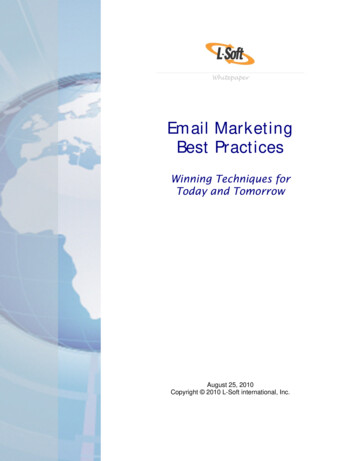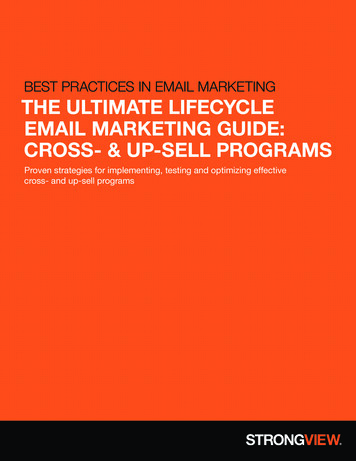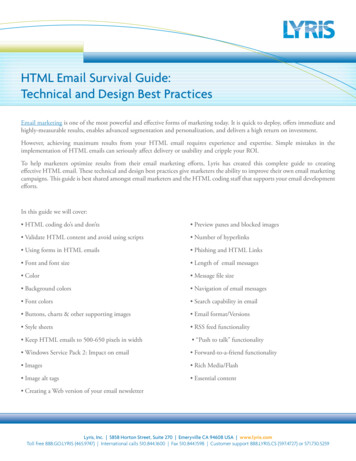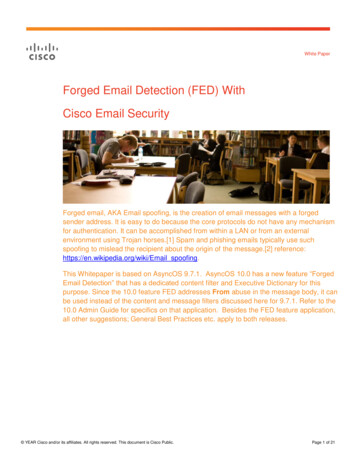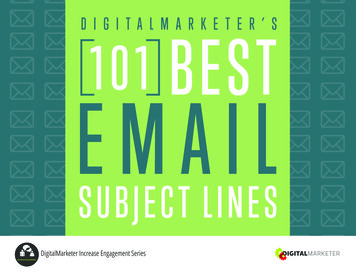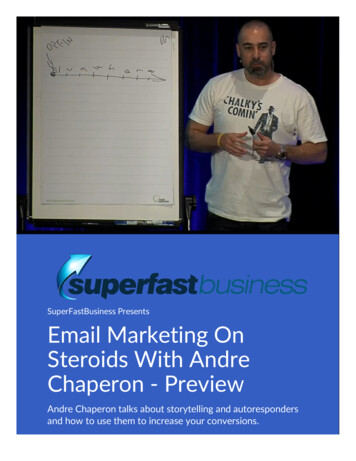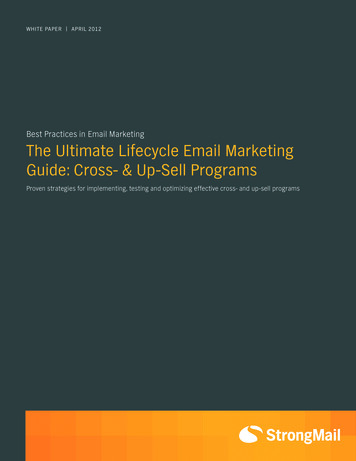
Transcription
WHITE PAPER APRIL 2012Best Practices in Email MarketingThe Ultimate Lifecycle Email MarketingGuide: Cross- & Up-Sell ProgramsProven strategies for implementing, testing and optimizing effective cross- and up-sell programs
PUBLISHED BYUS HeadquartersStrongMail Systems, Inc.1300 Island Drive, Suite 200Redwood City, CA 94065P: 1 (650) 421-4200F: 1 (650) 421-4201UK HeadquartersStrongMail Systems UK Ltd.Atlantic HouseImperial WayReadingRG2 0TDP: 44 (0) 118 903 6068APAC HeadquartersXCOM MediaUnit 115 Lamington StreetNew FarmQueensland 4005AustraliaP: 61 7 3666 0544Copyright 2012 StrongMail Systems, Inc. All rights reserved.No part of the contents of this publication may be reproduced or transmitted inany form or by any means without the written permission of StrongMail Systems, Inc.STRONGMAIL and the STRONGMAIL logo are registered trademarks in the UnitedStates, other countries or both. All Rights Reserved.StrongMail Systems UK, Ltd is a company registered in England and Wales at 5 NewStreet Square, London EC4A 3TW. Reg. No. 6398867. VAT # GB 925 07 6228. TradingAddress: Atlantic House, Imperial Way, Reading, RG2 0TD, United Kingdom.
Table of ContentsWHAT IS IT?. 4WHY IT’S A GOOD IDEA. 4DEFINING TERMS. 5GETTING STARTED. 5Three Critical Components of a Successful Cross-Sell/Up-Sell Program.5MEASUREMENT. 7CROSS-SELL AND UP-SELL FOR NON-RETAILERS. 7OPTIMIZATION. 7Three Optimization Best Practices for Cross-Sell and Up-Sell Programs.7ANATOMY OF AN EFFECTIVE CROSS-SELL EMAIL PROGRAM. 8REQUIRED TECHNOLOGY. 9THE PAY OFF. 10ABOUT STRONGMAIL. 10
WHAT IS IT?Marketers do not need yet another Harvard Business School study to tell them that drivingincremental sales from a current customer costs a lot less than acquiring new ones. However,many marketers squander the incremental sales opportunities afforded them by their own emaillists. Email cross-sell and up-sell programs allow marketers to drive more profitable behavior fromthe customers and prospects they know best.While retailers mightseem to benefit mostfrom cross-sell andup-sell programs, thereis an opportunityfor all marketers toemploy these tactics.While retailers might seem to benefit most from cross-sell and up-sell programs, there is anopportunity for all marketers to employ these tactics. Marketers who successfully drive acustomer to an online or live event, for instance, can use cross-sell and up-sell messages to drivethe customer to other events. Similarly, marketers dealing with long purchase cycles (e.g. thosein business-to-business) can use these tactics to increase awareness and interest for increasinglyvaluable products and services.Despite the potential of cross-sell/up-sell programs, fewer companies avail themselves of thistactic than you might think. In a recent StrongMail industry survey1, only 37% of marketers saidthey integrated cross-sell or up-sell tactics into their email programs for the 2011 Holiday period.Do not confuse the lack of implementation with a lack of interest. In the same survey, 45% ofemail marketers identified their biggest email challenge as integration of customer data and 43%pointed to lack of resources or staff. This whitepaper will discuss both the benefits of cross-selland up-sell offers in emails, as well as how a wide variety of email marketers can take advantageof the tactics regardless of available resources and data.WHY IT’S A GOOD IDEAAs noted above, cross-sell and up-sell programs offer opportunities for marketers to increaserevenue at a relatively small cost. Regardless of industry or channel, customer acquisition costsmoney – anywhere from pennies for simple search engine marketing (SEM) or banner campaigns,to hundreds of dollars for sophisticated multi-channel efforts in high-margin industries suchas financial services and insurance. In contrast, cross-sell and up-sell programs can be run at afraction of those costs because they do not require the expense of sifting good prospects froma bunch of hand-raisers. By definition, cross-sell and up-sell programs involve a cherry-pickedaudience – people who have already bought something from a marketer.Leveraging email for your cross- and up-sell programs offers two additional advantages:1.Low-cost channelEmail has proven itself as the highest bang-for-the-buck channel in all of marketing.No other channel comes close to the speed-to-market, mass-reach and timely impactof email. As a result, testing cross-sell and up-sell programs in email remains within thereach of every marketer.2.Available dataWhile top-flight cross-sell and up-sell programs involve data pulled from multiple sourcessuch as marketing and sales databases, even modestly functional email platforms canprovide relevant data.14StrongMail/Zoomerang, " 2012 Marketing Trends Survey," November 2011The Ultimate Lifecycle Email Marketing Guide: Cross- & Up-Sell ProgramsCopyright 2012 StrongMail Systems, Inc. All rights reserved. SM-DE-20612
DEFINING TERMSWhile marketing literature may lump cross-sell and up-sell together, it is helpful to define themindividually and to identify the key differences between them.Cross-sell refers to the tactic of recommending additional purchases based on a previouspurchase. Often, but not always, cross-sell involves selling items from categories other thanthe category of the initial purchase. For example, if a customer bought a sweater from aclothing retailer, both a matching shirt (from the clothing department) and a pendant (fromthe accessories department) might fall under the cross-sell banner.Up-sell refers to the tactic of selling enhancement to the existing purchase. In the brick-andmortar world, McDonalds practices up-selling every time they ask “would you like to supersize that?” Similarly, car dealers practice up-sell when they convince buyers to opt for a largeror more luxurious car than they initially intended to buy.While email sometimes engages in up-sell before purchase, it more often does so after purchase.As a result, up-sell usually takes the form of product-specific add-ons, such as extendedwarranties, optional features or enhanced services.The quality and quantityof customer dataavailable will determinethe flexibility andrelevance of cross-selland up-sell efforts.GETTING STARTEDMaking cross-sell and up-sell work in email requires nailing down three inputs: available customerdata, available resources and offer structure.Three Critical Components of a Successful Cross-Sell/Up-Sell Program1.Available Customer DataThe quality and quantity of customer data available will determine the flexibility andrelevance of cross-sell and up-sell efforts. The key word here is "available." Many marketershave petabytes of data on their customers, but those data often remain locked in pointof-sale (POS) or marketing databases due to security or technology issues. While marketersmay use these data to help inform cross-sell and up-sell programs, they may not be able touse the information to drive the actual process. Let’s look at some types of data and howmarketers can use them. Sales data come from POS or transactional systems and rank as the most valuableof all customer data. After all, nothing indicates interest better than an actual purchase.If marketers can pull these data into the email program, they can use them in both staticand dynamic ways.-- Static. Marketers can take an educated guess about which products go with whichpurchases using anecdotal information at either the product or category level.For instance, at the product level, anyone who buys a TV might also be interestedin video cables or a Blu-Ray player. Similarly, a marketer could simply have a basketof offers at the category level, such as offering the top five electronics products foranyone who has bought something electronic.-- Dynamic. Marketers with access to purchase models may employ offers based onproduct relationships. These relationships may stem from simple cluster analysisthat show other products bought in the same basket as a specific SKU or moreexotic next-best-offer models that involve greater sensitivity with the data. Dynamicapproaches require more analytics capabilities but generally improve relevance.5The Ultimate Lifecycle Email Marketing Guide: Cross- & Up-Sell ProgramsCopyright 2012 StrongMail Systems, Inc. All rights reserved. SM-DE-20612
Web analytics data allow marketers to target offers based on what the customer hasviewed on the marketer’s website. With these data, a marketer could send a purchaseran email with offers based on other products viewed during the session that resultedin the purchase. Preference data come from elections that customers have made when registeringfor email, usually via a preference center. These data can provide clues on a customer’sneeds. For instance, if a customer has asked for family content via a preference center,then the marketer could offer children’s products in a cross-sell or up-sell message,regardless of what she actually bought. Email response data come from the email platform (ESP). Enterprise email marketingsolutions like StrongMail Message Studio typically enable marketers to create segmentsbased on specific actions taken in email. Thus, a marketer could follow up a sale byemailing that customer an offer based on a previously viewed email offer. For example,if a customer bought a garlic peeler, the marketer could send an offer for a spatula thatthe customer viewed from a previous email.Enterprise emailmarketing solutions likeStrongMail MessageStudio typically enablemarketers to createsegments basedon specific actionstaken in email.Marketers with sufficient analytics abilities can blend these data together for even greaterdimensionality. More importantly, marketers should recognize that they can devise cross-selland up-sell tactics no matter what data is available.2.Available ResourcesNaturally, all the data in the world won’t make a difference if a marketer doesn’t have peopleor technology to bring those data to bear. Some resources include: Analysts who can manipulate the data mentioned above. Obviously, the more skilledthe analysts, the more useful the data. However, marketers without access to analysts stillhave the opportunity to employ common-sense static sales data as previously noted. Creative/production staff to develop offer modules or emails featuring cross-sell orup-sell. At its simplest, cross-sell or up-sell requires creating alternate versions of emailsthat include an offer based on data as described above. However, the approach quicklygets complicated and requires production staff who can employ code to pull in theoffers from a designated data source. Technology or personnel to create product adjacencies. Someone, or sometechnology, needs to build the offers. In the case of static sales data, a person with salesknowledge can create sales adjacencies based on history or educated guesses. However,using a recommendation engine based on analytical modeling generally works better,especially for marketers with hundreds or thousands of discrete products.3.Available CommunicationsA marketer also needs to think about where the cross-sell and up-sell offers should go.Some good options include: Transactional messages such as purchase confirmations and shipping notifications.Direct marketers proved the adage “it’s never too early to make the next sale” decadesago. These opportunities take advantage of the additional attention that customerstraditionally give to transactional messaging. Remember, however, to comply withCAN-SPAM regulations and make sure the transactional message is front and center.As a general rule, you should also limit your marketing messages to a third of the totalmessage area. Triggered messages such as abandoned cart or web-analytics-driven emails. Takeadvantage of customer interest by targeting messages based on their interests. Offersalong the lines of “you may also be interested in” work by reminding customers ofsomething they’ve done on a marketer’s website.6The Ultimate Lifecycle Email Marketing Guide: Cross- & Up-Sell ProgramsCopyright 2012 StrongMail Systems, Inc. All rights reserved. SM-DE-20612
Regularly-scheduled emails such as newsletters or typical sales emails. Marketers canreally learn about how cross-sell and up-sell offers perform alongside more broad-basedoffers. However, be careful to prevent unfortunate coincidences. An email announcinga spring sale would look funny, for example, if the cross-sell or up-sell offer next to itsuggested a winter coat based on the user’s browsing history.When a marketerapplies cross-sell orup-sell tactics, he orshe should comparethe success of tacticsagainst a like samplethat does not receivethem but that still doesreceive relevant emails. Ad-hoc emails. Single-purpose emails enjoy the advantage of focus. However, addinga cross-sell or up-sell message may enhance their impact by involving the customermore completely.MEASUREMENTDetermining success of cross-sell and up-sell depends on the data abilities of the marketer. Sales,of course, represent the clearest indication of success. However, marketers should also considerthe following: Use a control sample to determine lift. When a marketer applies cross-sell or up-selltactics, he or she should compare the success of tactics against a like sample that doesnot receive them but that still does receive relevant emails. Practically speaking, it meanscreating two or more versions of the communications in question—one or more withcross-sell/up-sell tactics and one with static offers or no offers. Only by comparing thetactics against a control can a marketer determine the actual value of the offers. Use response data as a proxy if necessary. This should be done if sales from thecommunication cannot be calculated directly. While click data alone do not immediatelytranslate into sales figures, they’re better than nothing!CROSS-SELL AND UP-SELL FOR NON-RETAILERSWhile non-retailers do not sell in the traditional sense, they can also benefit from cross-sell andup-sell tactics. A publisher, for instance, might use them to find content of interest to their readers.Manufacturers might use them to help customers find products that complement their pastpurchases or actions. The same tactics and measurements generally apply across the board.OPTIMIZATIONCross-sell and up-sell offers run a broad gamut from simple product-category suggestions tosophisticated next-logical-product offer models. Few marketers have the resources or stamina tojump into more complex applications first.Three Optimization Best Practices for Cross-Sell and Up-Sell Programs1.Start smallTry simple applications of cross-sell and up-sell. As a suggestion, identify a product categorywith well-known product adjacencies and manually create offers relevant to the category(e.g. cross-sell coffee grinders to coffee maker purchasers) and measure success.2.Add scaleRoll out offers to other categories or products as resources allow. Observe how cross-sell andup-sell offers perform in different categories.3.Add sophisticationAssuming that cross-sell and up-sell offers perform well, improve performance by testingdynamic offer insertion and modeling to fine-tune the emails. Over time, modeling will getmore and more accurate.7The Ultimate Lifecycle Email Marketing Guide: Cross- & Up-Sell ProgramsCopyright 2012 StrongMail Systems, Inc. All rights reserved. SM-DE-20612
ANATOMY OF AN EFFECTIVE CROSS-SELL EMAIL PROGRAMThe following product review email from Real Networks' GameHouse division leveragespurchase history data to serve up relevant game titles from a pool of popular and new releases.GameHouse uses StrongMail to automatically trigger this subscriber email after a preset intervalfrom the highlighted purchase, with the main focus on soliciting a product review. By insertingrelevant cross-sell offers into an email template with a clean design and singular call-to-action,GameHouse is able to limit distraction and increase conversions.Recent game purchasers aretargeted after a preset intervalfrom purchase dateEmail serves up a relevantselection of top sellers andnew releasesClean email design prominentlyfeatures cross-sell offers withoutoverpowering main messageInserting cross-sell offers intoa template with only one othercall-to-action helps facilitateconversions8The Ultimate Lifecycle Email Marketing Guide: Cross- & Up-Sell ProgramsCopyright 2012 StrongMail Systems, Inc. All rights reserved. SM-DE-20612
REQUIRED TECHNOLOGYUnlike traditional outbound batch-and-blast email marketing campaigns, cross-sell and up-sellemail programs are typically triggered by a purchase process, which requires real-time integrationwith e-commerce systems, web analytics, recommendation engines, customer databases and/orother external systems. Once those integrations are in place, the message needs to be assembleddynamically based on available information and, finally, be delivered in the timeframe that youhave tested to be most effective.This entire process requires a triggered or transactional email solution that not only ties intoyour data warehouse and other systems, but that also provides you with in-depth reporting togauge deliverability and engagement, as well as full HTML customization capabilities to ensurevisual consistency with your other email communications. Cross- and up-sell email programs aremost effectively served by a lifecycle email marketing solution that allows you to easily set upappropriate triggers, customize wait intervals, test offers and optimize performance in real-time.If you aren't currently able to dynamically assemble and send event-triggered emails with fulltracking capabilities, you should look at upgrading your system to ensure that your customersreceive timely and relevant messages. Marketers should also seriously consider a systemwith lifecycle marketing capabilities that will allow you to easily create a flow that maximizesengagement and conversions.Below is an example of a cross-sell program designed with StrongMail's drag-and-drop lifecyclemarketing solution. As illustrated below, a triggered email program can be initiated by integrationwith an e-commerce systems and then integrate “wait" steps and actions that generate differentflows (which can be tested for maximum engagement).In the scenario below, a customer books a cruise vacation and receives a confirmation emailwith a cross-sell offer for a discounted, shipboard spa treatment. If the passenger converts on theoffer, s/he receives a confirmation email with another upsell-offer: a triple upgrade for the priceof a double. If the passenger doesn't convert, s/he receives an email a week later with a differentupsell offer: a double upgrade for the price of a single upgrade.Create multi-stepprograms with dragand-drop simplicityDynamically assemble and sendcustomized m
Email response data come from the email platform (ESP). Enterprise email marketing solutions like StrongMail Message Studio typically enable marketers to create segments based on specific actions taken in email. Thus, a marketer could follow up a sale by emailing that customer an off
